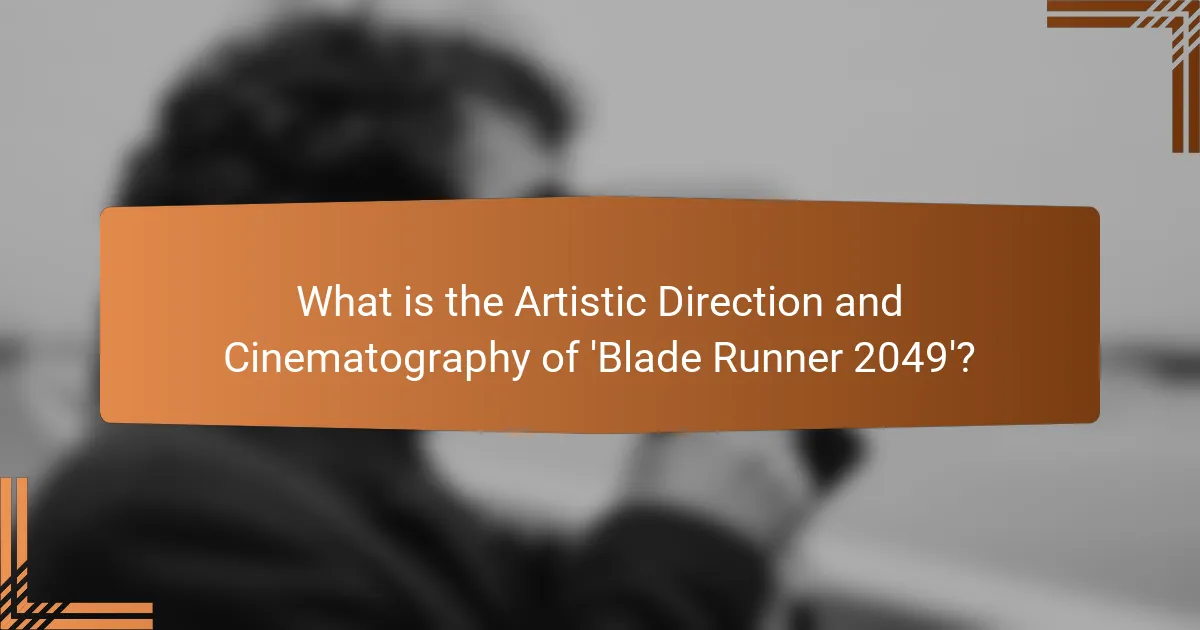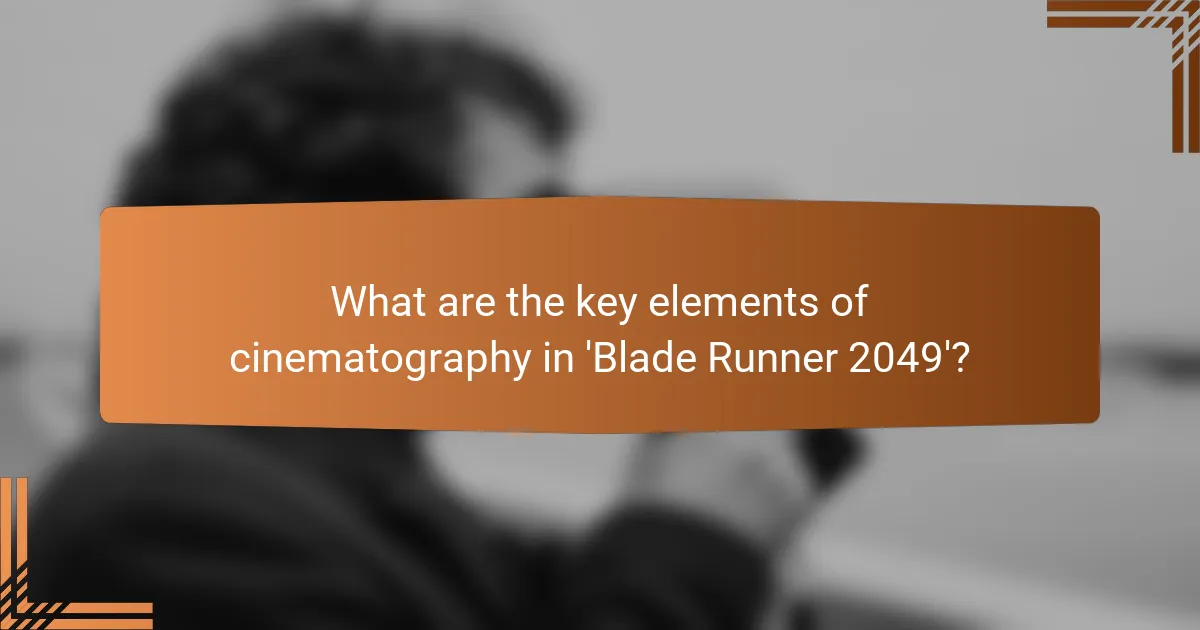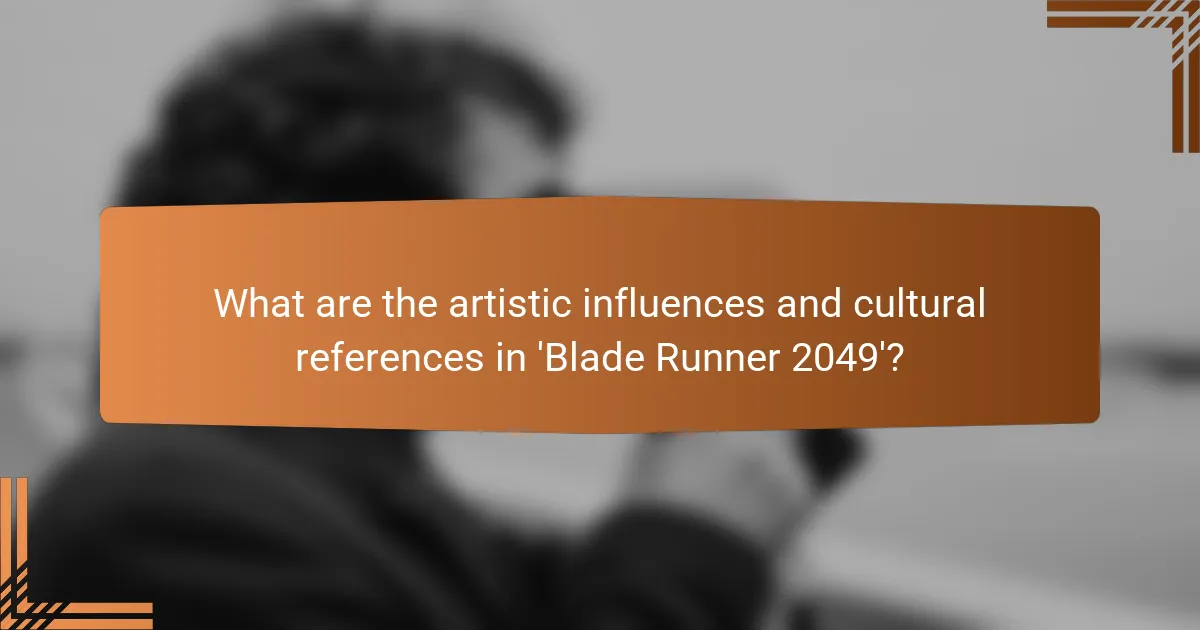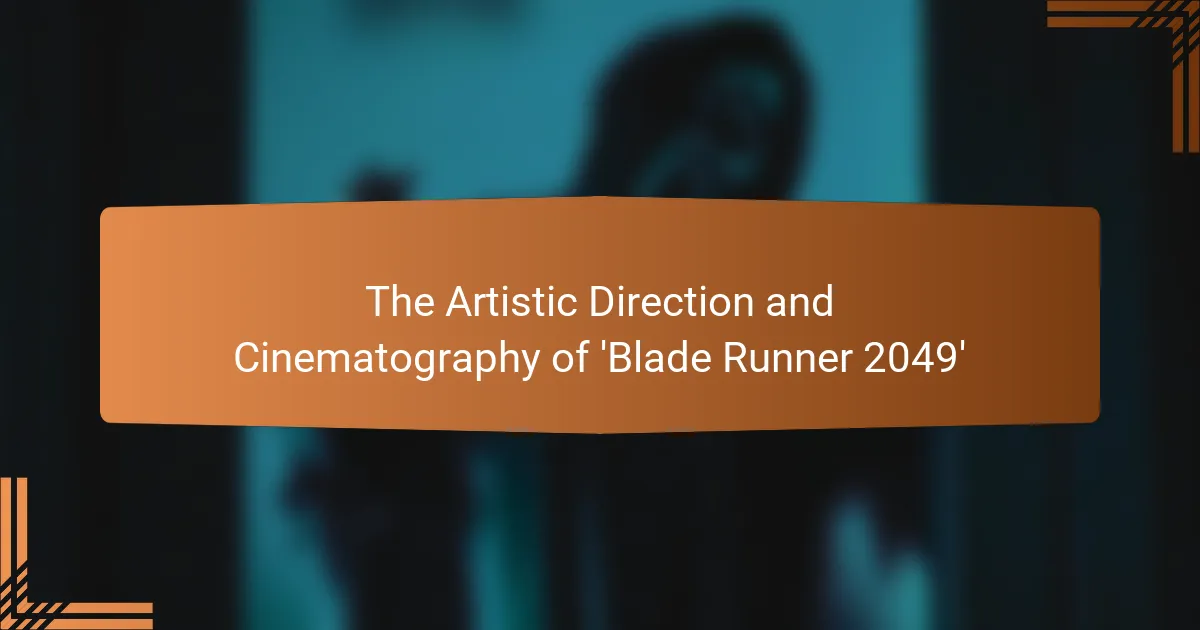The article examines the artistic direction and cinematography of the film ‘Blade Runner 2049,’ directed by Denis Villeneuve and featuring cinematography by Roger Deakins. It highlights the film’s visually stunning style, characterized by a rich color palette, intricate lighting, and innovative techniques that enhance visual storytelling. Key elements such as lighting, composition, color palette, and camera movement are discussed, showcasing how they contribute to the film’s atmosphere and themes of identity and humanity. The article also explores the influences of various artistic movements, cultural references, and the film’s connection to its predecessor, ‘Blade Runner’ (1982), while emphasizing Deakins’ Academy Award-winning work.

What is the Artistic Direction and Cinematography of ‘Blade Runner 2049’?
The artistic direction and cinematography of ‘Blade Runner 2049′ are characterized by a visually stunning and immersive style. Directed by Denis Villeneuve, the film employs a rich color palette and intricate lighting to create a dystopian atmosphere. Cinematographer Roger Deakins utilized innovative techniques, including natural light and expansive landscapes, to enhance the film’s visual storytelling. The use of practical effects alongside CGI adds depth and realism to the scenes. Deakins’ work earned him an Academy Award for Best Cinematography, underscoring the film’s visual excellence. The artistic direction effectively reflects themes of identity and humanity, contributing to the film’s critical acclaim.
How does the artistic direction shape the film’s narrative?
Artistic direction significantly shapes the narrative of a film by influencing its visual storytelling. In ‘Blade Runner 2049’, the artistic direction creates a distinct atmosphere that reflects the themes of isolation and dystopia. The use of color palettes, lighting, and set design contributes to the emotional tone of the story. For instance, the stark contrasts between bright and dark scenes emphasize the internal conflicts of characters. Additionally, the visual motifs reinforce the narrative’s exploration of identity and humanity. The meticulous attention to detail in production design enhances the viewer’s immersion in the film’s world. Cinematography choices, such as framing and camera movement, further guide audience perception and engagement with the narrative. Overall, artistic direction is integral to conveying complex themes and emotions in ‘Blade Runner 2049’.
What visual themes are prevalent in ‘Blade Runner 2049’?
‘Blade Runner 2049’ features several prevalent visual themes, including dystopian landscapes, neon lighting, and contrasts between natural and artificial elements. The film’s cinematography showcases a bleak, futuristic world filled with towering structures and desolation. Neon lights create a vibrant yet oppressive atmosphere, emphasizing the technological advancements and societal decay. The use of color, particularly blues and oranges, enhances emotional depth and visual storytelling. Natural elements, such as water and earth, are juxtaposed with the synthetic environment, highlighting the tension between humanity and technology. These themes contribute to the film’s exploration of identity and existence in a complex world.
How do color palettes influence the mood of the film?
Color palettes significantly influence the mood of a film. In ‘Blade Runner 2049’, the use of color creates emotional depth. Warm colors evoke feelings of comfort and nostalgia. Cool colors often generate a sense of isolation or unease. The film employs a muted color scheme to reflect dystopian themes. This choice enhances the viewer’s experience of despair and longing. Studies show that color can affect psychological responses. For example, blue hues can induce calmness, while red can provoke excitement or tension. The strategic use of color in ‘Blade Runner 2049’ effectively shapes audience perception and emotional engagement.
What role does cinematography play in storytelling?
Cinematography plays a crucial role in storytelling by visually conveying emotions and themes. It shapes the audience’s perception of characters and their journeys. Through lighting, camera angles, and shot composition, cinematography creates mood and atmosphere. For instance, in ‘Blade Runner 2049’, the use of contrasting colors enhances the dystopian setting. The framing of shots influences how viewers connect with the narrative. Dynamic camera movements can heighten tension or reflect character psychology. Cinematography also guides the pacing of the story, impacting the viewer’s experience. Overall, it serves as a visual language that complements the script and performances.
How do camera angles and movements enhance the viewing experience?
Camera angles and movements significantly enhance the viewing experience by influencing audience perception and emotional engagement. Different angles can create various effects, such as intimacy or tension. For instance, a low angle can make a character appear powerful, while a high angle can suggest vulnerability. Dynamic movements, like panning or tracking shots, can guide viewer attention and create a sense of motion. In ‘Blade Runner 2049’, these techniques are employed to immerse viewers in the film’s dystopian world. Specific scenes utilize wide shots to showcase the vastness of the environment, enhancing the feeling of isolation. Additionally, close-ups are used to capture subtle emotional nuances in characters, deepening audience connection. Overall, thoughtful camera angles and movements are essential tools in cinematic storytelling, shaping how viewers experience the narrative.
What techniques are used to create depth and perspective?
Depth and perspective in ‘Blade Runner 2049’ are created using techniques like layering, atmospheric perspective, and leading lines. Layering involves placing objects at different distances from the camera. This creates a sense of three-dimensional space. Atmospheric perspective uses color and clarity to suggest depth. Objects in the background appear lighter and less defined. Leading lines guide the viewer’s eye toward focal points in the composition. These lines enhance the illusion of depth. The use of wide-angle lenses also contributes to the perception of space. These techniques work together to immerse viewers in the film’s visual narrative.
Why is the collaboration between the director and cinematographer significant?
The collaboration between the director and cinematographer is significant because it shapes the visual storytelling of a film. This partnership ensures that the director’s vision is effectively translated through the camera’s lens. The cinematographer brings technical expertise to realize the director’s artistic concepts. In ‘Blade Runner 2049’, director Denis Villeneuve and cinematographer Roger Deakins worked closely to create a distinct visual style. Their collaboration resulted in striking imagery that enhances the film’s themes. For instance, the use of lighting and color palettes was meticulously planned to evoke specific emotions. This synergy is crucial for maintaining consistency in tone and atmosphere throughout the film. Ultimately, their collaboration elevates the narrative by creating a cohesive visual experience.
What is the impact of Denis Villeneuve’s vision on the film’s aesthetic?
Denis Villeneuve’s vision significantly shapes the aesthetic of ‘Blade Runner 2049’. His approach emphasizes a hauntingly beautiful visual style. Villeneuve collaborates closely with cinematographer Roger Deakins. This partnership results in striking imagery and meticulous framing. The use of color contrasts enhances emotional depth. Villeneuve’s focus on world-building immerses viewers in the dystopian setting. He prioritizes atmosphere over action, creating a contemplative tone. The film’s pacing allows for visual storytelling to unfold gradually. Overall, Villeneuve’s artistic direction creates a unique cinematic experience that resonates with audiences.
How does Roger Deakins’ cinematography contribute to the overall atmosphere?
Roger Deakins’ cinematography significantly enhances the overall atmosphere of ‘Blade Runner 2049′. His use of lighting creates a stark contrast between shadows and highlights. This technique evokes a sense of mystery and tension throughout the film. Deakins employs a color palette that reflects the desolation of the film’s setting. The muted tones contribute to a feeling of bleakness and existential dread. His framing of shots often isolates characters within vast environments. This visual choice emphasizes their loneliness and struggle. Deakins’ mastery of depth of field draws attention to key elements, enhancing emotional impact. Overall, his cinematography is integral to crafting the film’s immersive and haunting atmosphere.

What are the key elements of cinematography in ‘Blade Runner 2049’?
The key elements of cinematography in ‘Blade Runner 2049’ include lighting, composition, color palette, and camera movement. The lighting creates a distinct atmosphere, often utilizing high contrast and shadows to enhance the mood. Composition is meticulously crafted, with symmetrical framing and layered visuals that draw the viewer’s eye. The color palette features vibrant neons alongside muted tones, symbolizing the film’s themes. Camera movement is deliberate, using slow tracking shots to immerse the audience in the world. These elements work together to create a visually stunning narrative that complements the story. The cinematography, led by Roger Deakins, received critical acclaim, winning an Academy Award for Best Cinematography.
How does lighting contribute to the film’s visual storytelling?
Lighting significantly enhances the visual storytelling in ‘Blade Runner 2049’. It sets the mood and tone of each scene. High-contrast lighting creates tension and highlights emotional states. Soft lighting evokes intimacy and warmth. The use of color in lighting conveys thematic elements, such as isolation or hope. For instance, the prevalence of neon lights symbolizes the dystopian environment. Shadows are strategically used to create mystery and depth. Overall, lighting in the film shapes audience perception and engagement with the narrative.
What types of lighting techniques are employed throughout the film?
The film ‘Blade Runner 2049’ employs several lighting techniques to enhance its visual storytelling. Key techniques include high-contrast lighting, which creates dramatic shadows and highlights. The film utilizes practical lighting sources, such as neon signs, to establish a futuristic ambiance. Soft lighting is also present, particularly in intimate scenes, to evoke emotion. Color gels are employed to create atmospheric effects and symbolize themes. Backlighting is frequently used to create silhouettes and depth. The combination of these techniques contributes to the film’s distinctive aesthetic. Each lighting choice is deliberate, supporting the narrative and character development throughout the film.
How does natural vs. artificial lighting affect scenes?
Natural lighting creates a softer, more organic atmosphere in scenes, while artificial lighting offers control and dramatic effects. Natural light varies with time of day and weather, influencing mood and realism. It often enhances textures and colors, providing a more immersive experience. In contrast, artificial lighting allows for precise manipulation of shadows and highlights. It can shape characters’ emotions and emphasize narrative elements. For example, in ‘Blade Runner 2049’, artificial lighting is used to create stark contrasts and highlight the dystopian environment. This technique enhances the film’s themes of isolation and existential struggle. The combination of both lighting types contributes to the film’s unique visual style and storytelling.
What camera techniques are utilized to create unique visuals?
Camera techniques utilized to create unique visuals include depth of field, framing, and lighting. Depth of field creates a sense of focus on subjects while blurring the background. This technique enhances emotional impact by isolating characters. Framing involves composing shots to guide viewer attention. It can emphasize scale and relationships between elements. Lighting shapes mood and atmosphere, often using high contrast to create tension. In ‘Blade Runner 2049’, these techniques are employed to evoke a dystopian aesthetic. Cinematographer Roger Deakins used specific lighting setups to enhance the film’s visual storytelling. The combination of these techniques contributes to the film’s distinctive look and feel.
How does the use of wide shots versus close-ups affect audience perception?
Wide shots create a sense of space and context, while close-ups focus on details and emotions. Wide shots establish the environment and relationships between characters. They can evoke feelings of isolation or grandeur, depending on the scene. Close-ups draw attention to [censured] expressions and nuances. This technique fosters intimacy and connection with characters. In ‘Blade Runner 2049’, wide shots highlight the vastness of the dystopian world. Close-ups reveal the internal struggles of characters like K. Research shows that emotional engagement increases with close-up shots, as noted in studies on audience response to visual media. Thus, the balance between these shots shapes audience perception significantly.
What role does lens choice play in the cinematography of the film?
Lens choice significantly influences the cinematography of a film. It affects the visual storytelling and emotional impact. Different lenses create varied perspectives, depth, and focus. For instance, wide-angle lenses can exaggerate space and create a sense of vastness. In contrast, telephoto lenses compress distance and isolate subjects.
In ‘Blade Runner 2049’, the use of specific lenses enhances the film’s dystopian atmosphere. The filmmakers employed anamorphic lenses to achieve a unique visual style. This choice contributed to the film’s iconic look by creating characteristic lens flares and a shallow depth of field.
Furthermore, lens choice plays a crucial role in framing and composition. It determines how characters and environments interact visually. The deliberate selection of lenses shapes the audience’s perception and emotional response to the narrative.
How does composition influence the viewer’s experience?
Composition significantly influences the viewer’s experience by guiding their attention and shaping emotional responses. In ‘Blade Runner 2049’, composition establishes visual hierarchy. It uses framing to direct focus on key elements within a scene. For instance, symmetrical compositions create a sense of balance and order. Conversely, asymmetrical compositions evoke tension and unease. The placement of characters within the frame affects viewer empathy. Close-ups foster intimacy, while wide shots emphasize isolation. Color and light in composition further enhance mood. Dark shadows can create mystery, while bright lighting conveys hope. Research shows that viewers respond emotionally to visual composition. A study by Palmer et al. (2013) found that compositional elements significantly impact viewer interpretation and emotional engagement. Thus, composition is crucial in shaping the overall experience of ‘Blade Runner 2049’.
What framing techniques are used to convey themes and emotions?
Framing techniques in ‘Blade Runner 2049′ include the use of composition, camera angles, and depth of field. These techniques effectively convey themes and emotions throughout the film. For example, close-up shots emphasize characters’ emotional states. Wide shots often illustrate isolation and dystopian settings. Low angles can depict power dynamics, while high angles may suggest vulnerability. The use of negative space enhances feelings of emptiness and despair. Additionally, shallow depth of field focuses attention on specific elements, guiding viewer emotions. These techniques work together to create a visually rich narrative that supports the film’s themes.
How does symmetry and balance in shots enhance storytelling?
Symmetry and balance in shots enhance storytelling by creating visual harmony and guiding the viewer’s attention. This technique establishes a sense of order and stability within the narrative. In ‘Blade Runner 2049′, symmetrical compositions often reflect the characters’ emotional states. Balanced shots can evoke feelings of tranquility or tension, depending on the context. For example, scenes featuring the protagonist in symmetrical framing emphasize his isolation. This visual approach supports the film’s themes of duality and existential struggle. Cinematic symmetry also allows for deeper engagement with the story. It invites viewers to explore the underlying emotional and philosophical layers present in the narrative.

What are the artistic influences and cultural references in ‘Blade Runner 2049’?
‘Blade Runner 2049’ is influenced by various artistic movements and cultural references. The film draws heavily from film noir aesthetics, characterized by its use of shadow, light, and urban landscapes. It also references Japanese anime, particularly in its visual style and themes of identity. The influence of the original ‘Blade Runner’ (1982) is evident in its world-building and philosophical questions. Additionally, the film incorporates elements of existentialism, reflecting on what it means to be human.
Cinematographer Roger Deakins employs techniques reminiscent of classic paintings, enhancing the film’s visual storytelling. The use of color palettes evokes emotions similar to those found in works by artists like Edward Hopper. Cultural references include nods to contemporary issues such as artificial intelligence and environmental concerns. The film’s score by Hans Zimmer and Benjamin Wallfisch also pays homage to Vangelis’s original score, linking the two films thematically and sonically.
How do previous works influence the artistic direction of the film?
Previous works significantly shape the artistic direction of a film. In the case of ‘Blade Runner 2049’, the original ‘Blade Runner’ set a visual and thematic foundation. The use of neo-noir aesthetics and dystopian elements in the original film influenced the sequel’s design choices. Cinematographer Roger Deakins drew on these styles to create a cohesive visual narrative. Additionally, other films within the genre served as references for color palettes and lighting techniques. The historical context of science fiction cinema also informed the film’s approach to world-building. This interplay of influences ensured that ‘Blade Runner 2049’ resonated with both fans and new audiences. The artistic direction thus reflects a dialogue with its predecessors.
What films or art movements inspired the visual style of ‘Blade Runner 2049’?
‘Blade Runner 2049’ was inspired by several films and art movements. The original ‘Blade Runner’ (1982) set a foundational aesthetic. German Expressionism influenced the film’s use of shadow and light. Films like ‘Metropolis’ (1927) contributed to its dystopian architecture. The works of director Ridley Scott also informed its visual storytelling. Additionally, contemporary artists like Syd Mead shaped its futuristic design. The film’s color palette reflects the influence of Impressionism. Overall, these elements combine to create a distinct visual style in ‘Blade Runner 2049’.
How does the film pay homage to its predecessor, ‘Blade Runner’?
‘Blade Runner 2049’ pays homage to its predecessor, ‘Blade Runner’, through visual and thematic parallels. The film mirrors the original’s neo-noir aesthetic with its use of dark, atmospheric lighting. Iconic elements such as the cityscape and replicants are revisited, reinforcing the original’s world. Music composed by Hans Zimmer and Benjamin Wallfisch echoes Vangelis’ score from the first film. The sequel also references specific scenes, like the iconic spinner vehicles. Additionally, it explores similar existential themes, questioning identity and humanity. These elements collectively create a sense of continuity and respect for the original film’s legacy.
What cultural elements are reflected in the cinematography?
The cinematography of ‘Blade Runner 2049’ reflects various cultural elements such as dystopian themes, technological advancement, and environmental decay. The use of neon lighting highlights a cyberpunk aesthetic, representing a fusion of high technology and low life. Cultural references to Asian influences are evident in the urban landscape, showcasing a blend of global cultures. The portrayal of isolation and existentialism is reinforced through wide shots of desolate environments. Additionally, the film’s color palette emphasizes contrasts between warmth and coldness, symbolizing humanity’s struggle. These visual choices collectively illustrate societal concerns about the future.
How does the film’s setting reflect contemporary societal issues?
The setting of ‘Blade Runner 2049’ reflects contemporary societal issues through its depiction of urban decay and environmental degradation. The film portrays a dystopian future where pollution and climate change have drastically altered the landscape. Skyscrapers are shrouded in smog, symbolizing the consequences of industrialization. The stark contrast between wealth and poverty is evident in the living conditions of the characters. This mirrors current societal disparities in access to resources and opportunities. Additionally, the presence of artificial beings raises ethical questions about identity and humanity. These themes resonate with ongoing debates about technology’s impact on society. Overall, the film’s setting serves as a cautionary tale about the trajectory of modern civilization.
What symbolism is present in the cinematographic choices?
Cinematographic choices in ‘Blade Runner 2049′ symbolize themes of isolation and identity. The use of color palettes, such as desaturated tones, emphasizes a bleak, dystopian environment. Low lighting often represents the characters’ internal struggles and moral ambiguity. Wide shots highlight the vastness of the landscape, reinforcing feelings of loneliness. Close-ups focus on characters’ expressions, symbolizing their search for connection. The contrast between light and shadow signifies the duality of human nature. These visual techniques collectively enhance the narrative’s exploration of existence and humanity.
What practical tips can filmmakers learn from ‘Blade Runner 2049’?
Filmmakers can learn several practical tips from ‘Blade Runner 2049’. First, they should focus on creating a strong visual identity. The film uses color palettes and lighting to evoke emotions and set the tone. Second, filmmakers should prioritize world-building. The detailed environments enhance the narrative and immerse the audience. Third, they can learn the importance of sound design. The film’s score complements visuals and adds depth to scenes. Fourth, pacing is crucial. The film balances slow moments with action to maintain viewer engagement. Lastly, collaboration with cinematographers is essential. The partnership between the director and cinematographer resulted in stunning visuals that support the story. These elements contribute to the film’s overall impact and effectiveness.
The main entity of this article is the artistic direction and cinematography of ‘Blade Runner 2049’. The article provides a detailed examination of how director Denis Villeneuve and cinematographer Roger Deakins collaborated to create a visually stunning film characterized by a rich color palette, innovative lighting techniques, and thematic depth. It explores the impact of artistic direction on narrative, prevalent visual themes, and the significance of cinematography in storytelling. Additionally, the article highlights the influence of previous works, cultural references, and practical filmmaking tips derived from the film’s aesthetic choices.
